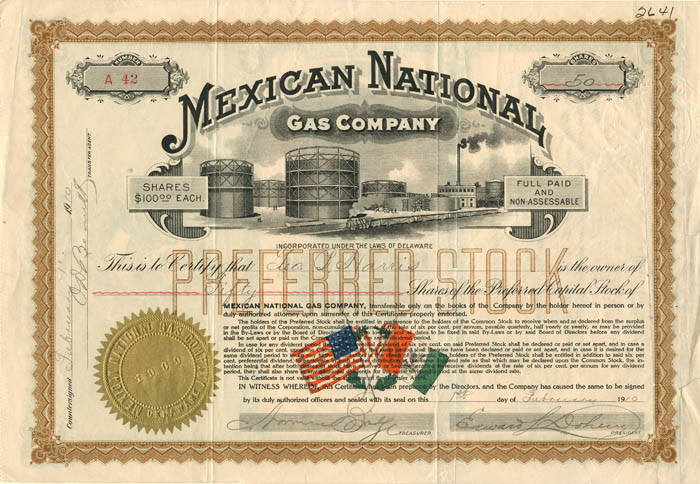Mexican National Gas Co. - signed as president by Edward L. Doheny
Inv# FS1502
Stock signed by Edward L. Doheny.
Edward Laurence Doheny (August 10, 1856 - September 8, 1935) was an American oil tycoon, who in 1892, along with business partner Charles A. Canfield, drilled the first successful oil well in the Los Angeles City Oil Field, setting off the petroleum boom in Southern California. At first he was an unsuccessful prospector in the state of New Mexico and Southwestern United States. Later Doheny became very wealthy through his California oil interests, and was also successful in the oil fields of Tampico, Mexico. During the administration of President Warren G. Harding, Doheny was implicated in the Teapot Dome Scandal and was accused of offering a $100,000 bribe to Secretary of the Interior Albert Fall in order to secure drilling rights without competitive bidding to the Elk Hills Naval Petroleum Reserve in central California. He was twice acquitted of offering the bribe that Fall was convicted of accepting. Doheny and his second wife and widow, Carrie Estelle, were noted philanthropists in Los Angeles. The character J. Arnold Ross in Upton Sinclair's 1927 novel Oil! (the inspiration for the 2007 film There Will Be Blood) is loosely based on Doheny.
Doheny graduated from high school at the age of 15 and he was named the valedictorian of his class. Following his father’s death several months after his graduation, he was employed by the U.S. Geological Survey, and in 1873 was sent to Kansas with a party surveying and subdividing the Kiowa-Comanche lands. The following year he left the Geological Survey to pursue his fortune prospecting, first in the Black Hills of South Dakota and then in Arizona Territory and New Mexico Territory. He is listed in the 1880 United States Census as a "painter" living in Prescott, Arizona. Later in 1880 he was in the Black Range in western Sierra County of southwestern New Mexico Territory, living in the rough silver-mining town of Kingston prospecting, mining, and buying and trading mining claims. During his time in Kingston he met two men who would play important roles in his later life; Albert Fall, the future Secretary of the Interior, and his business partner Charles A. Canfield. Doheny and Canfield together worked the former’s Mount Chief Mine with little success, and thus in 1886 Canfield prospected further in the Kingston area, leasing and developing with great success the Comstock Mine (not to be confused with the Comstock Lode of Virginia City, Nevada). Doheny declined to join him in this venture, and whereas Canfield made a small fortune from it, Doheny was reduced eventually to doing odd jobs (including painting) to support his family. In the Spring of 1891, Doheny left New Mexico and moved to Los Angeles, California, attracted by Canfield’s success in Los Angeles real estate. Canfield had previously left New Mexico with $110,000 in cash from his Comstock Mine venture, a sum that he parlayed into extensive real estate holdings during the Los Angeles boom of the later 1880s. With the collapse of the speculative fever, Canfield lost his wealth and land holdings and, by the time Doheny arrived in Los Angeles in 1891, was deeply in debt. Briefly the two men tried their prospecting luck in the San Diego County area of Southern California, forming the Pacific Gold and Silver Extracting Company there, but without achieving success they soon returned to Los Angeles. By 1892, Doheny was so poor he could not afford to pay for his boarding room. While in Los Angeles, Doheny found out that there were reserves of pitch (tar-asphalt) beneath the surface. Doheny obtained a lease near downtown with $400 in financing from Canfield, who had made some money from the mining industry. In the fall of 1892 Doheny dug a well with picks and shovels, and a windlass, looking for pitch, from which petroleum could be extracted. When the well (6 feet x 4 feet wide) reached a depth of 155 feet Doheny devised a drilling system involving a eucalyptus tree trunk. The well, when completed in 1893, reached a total depth of 225 feet and produced 40 barrels per day.
Very minor margin tear otherwise very nice.










Ebay ID: labarre_galleries